COURT REPORTING IN COLUMBUS AND ACROSS OHIO
Remote Depositions, Real Time Reporting, and Legal Videography in Columbus, Ohio
The History of Court Reporters’ Secret Weapon
Information and graphics presented by stenograph.com
In 1877, the world of court reporting was forever changed by the first shorthand machine (or stenograph). Learn more about how court reporting technology has evolved over the past 150 years by continuing reading.
The Stenograph Shorthand Machine (1877)

Miles Bartholomew (nicknamed the “Father of the Stenograph”) invented the first shorthand machine in 1877. Ten keys could be depressed one at a time to create a series of dots and dashes similar to Morse code. This was the first machine to be regularly successfully used in the court reporting field.
Anderson Shorthand Typewriter (1889)
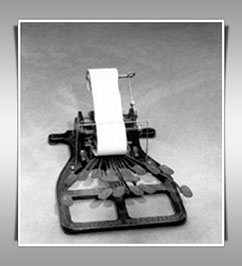 Created by George Kerr Anderson. This shorthand machine had the first keyboard that allowed two or more of its keys to be pressed at the same time. Unlike Bartholomew’s machine, this typewriter used English characters instead of code, which allowed words and symbols to be written.
Created by George Kerr Anderson. This shorthand machine had the first keyboard that allowed two or more of its keys to be pressed at the same time. Unlike Bartholomew’s machine, this typewriter used English characters instead of code, which allowed words and symbols to be written.
Ireland Stenotype Shorthand Machine (1911)

The Universal Stenotype Company made waves with their new machine that was a whole 40 pounds lighter than its predecessor! This was the first stenograph with a totally depressible keyboard, which gave reporters the ability to write numbers and words phonetically with fewer strokes. Business colleges began including instruction of this stenograph in their curriculums.
Master Model Stenotype (1914)
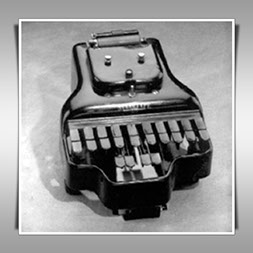 This machine was also invented by the Universal Stenotype Company, and now weighed only six pounds instead of eleven. Unfortunately, the Universal Stenotype Company went bankrupt during World War I.
This machine was also invented by the Universal Stenotype Company, and now weighed only six pounds instead of eleven. Unfortunately, the Universal Stenotype Company went bankrupt during World War I.
1927 LaSalle Stenotype
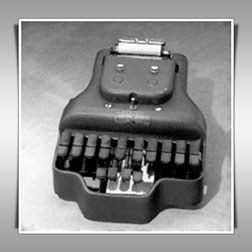
The “Master Model Four” used a two-spool ribbon system. The company did well under M.H. Wright, but unfortunately, the Great Depression cut its life short, and the court reporting profession also slowed down until the end of the 1930’s.
Stenograph Shorthand Machine
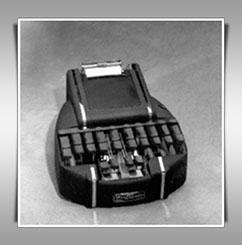
The Secretarial Model used a single 11-inch ribbon. The Secretarial held 100 folds of paper, and the Reporter model held 300. It was known for being dependable and quiet.
Stenograph Data Writer (1963)
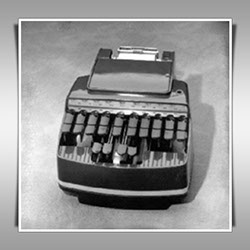
This model encoded a magnetic tape with machine notes for computer transcription. Its organ-type switches assured good contact and transmission with minimum key pressure. In 1963 it could be attached to a cable connected to a separate tape recorder. By 1970, cartridge was used instead, and by 1974 cassettes were used.
1982 Stenograph Machine
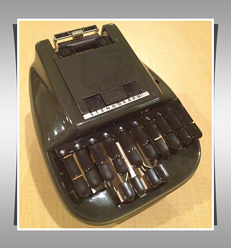 This iteration was the first to have a plastic shell, or casing, which made the machine more durable.
This iteration was the first to have a plastic shell, or casing, which made the machine more durable.
1987 SmartWriter
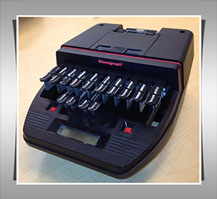
Now in the emerging digital age, the SmartWriter had the ability to encode machine notes on a floppy disk. It was considered state-of-the-art technology for its time– that is, until the next machine came along.
1992 Stenograph Stentura Series
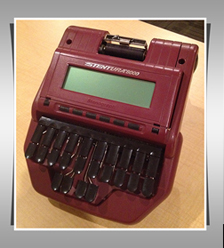 The Stentura was the first machine that featured instantaneous, realtime translation onto an LCD screen. It could be shown either in English, or Steno.
The Stentura was the first machine that featured instantaneous, realtime translation onto an LCD screen. It could be shown either in English, or Steno.
2001 élan Cybra
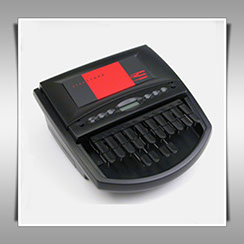
The élan Cybra was all important for transcriptionists, captioners, and CART reporters. It is paperless, inkless, ribbon-less, and greaseless. In 2006, a new version was introduced that included an optional wireless feature and was specifically designed for realtime transfer.
2003 élan Mira Series
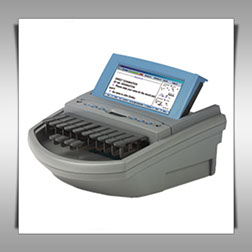
The Mira added the ability to flip the LCD screen upward for easier viewing, and featured Audiosync® OTG – on the go!, a USB port for writing realtime, and a DB9 serial port for use with wireless Bluetooth. This quickly became the standard machine for court reporting.
2005 Stentura Protégé Student
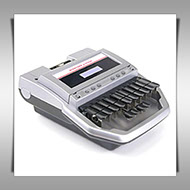 The Stentura Protégé was designed specifically for students. It features a USB and serial connectivity, as well as optional wireless realtime.
The Stentura Protégé was designed specifically for students. It features a USB and serial connectivity, as well as optional wireless realtime.
2005 Stentura élan Mira Student
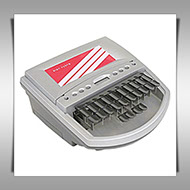 This machine was also designed students with students in mind, and was known as the “paperless writer for students.” It features the same technology as the professional version, but in a limited fashion at a student price.
This machine was also designed students with students in mind, and was known as the “paperless writer for students.” It features the same technology as the professional version, but in a limited fashion at a student price.
2006 Stentura Fusion
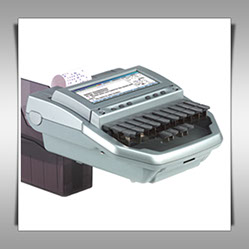
The Stentura Fusion replaced the Stentura LX. The key feature of this machine is its ability to use paper, or to be paperless. Other improvements include compatibility with SD cards, recording live testimony using AudioSync OTG – on the go!, USB and DB9 ports, and battery status display.
2009 The Diamante
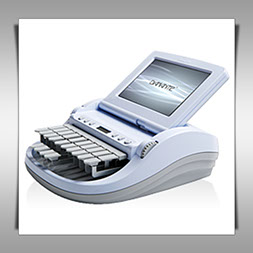
The Diamante’s TrueStroke® technology was leaps above any other steno-machines for speed and accuracy. It features a vibrant flat-panel display, two SD cards, two USB ports, microphone and headset jacks for AudioSync, and optional Bluetooth or WiFi realtime translation.
2015 The Luminex
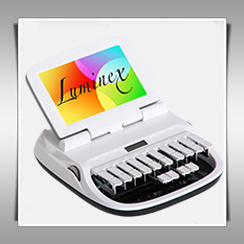
The Luminex features innovative technology and software. Duel key channels keep keys in alignment, and chrome plated key levers reduce friction and provide smoother action. The TrueStroke technology results in cleaner steno notes.

COURT REPORTING
Our highly experienced professionals are dedicated to providing quality, verbatim transcripts.
REMOTE DEPOSITIONS
Conduct a deposition from the comfort of your home.
LEGAL VIDEOGRAPHY
We produce a superior record in any format you choose.
VIDEOCONFERENCING
Connect with your legal team from anywhere.
TRIAL PRESENTATION
Take your trial to the next level with Anderson Trial Presentation Solutions.
REALTIME REPORTING
See your transcript in real time during your trial or deposition.
Contact Us
Columbus, Ohio Court Reporting & Legal News
ARS, a Top Choice for Court Reporting in Ohio
Across Ohio, lawyers and attorneys turn to experienced court reporters for assistance with prepping for lawsuits and litigation in cities across the state such as Columbus, Cleveland, Cincinnati, Toledo, Akron and Dayton. With more than three decades of experience...
Columbus Court Reporters Help Attorneys Win Cases Across Ohio
The wheels of justice never stop turning, so lawyers and attorneys across Ohio can keep busy helping residents of the state pursue restitution for damages they have suffered. To keep up with the demand, Ohio legal professionals often hire court reporting companies...
Providing Support to Lawyers Across Ohio for Personal Injury Cases and More
In cities and towns across Ohio, citizens have turned to lawyers and attorneys to seek justice after suffering harm and damages. Increasingly, legal professionals in cities across the state such as Columbus and Cleveland use the services of court reporting companies...
What is the Anderson Reporting Difference?
More than 30 years ago, our firm president Gayle Anderson saw the need for a court reporting firm that could live up to the high standards of local attorneys. They require a court reporter who is not only fast and accurate, but uses the latest technology in the...
What Can Video Marketing Do For You?
Credit: Network Deposition Services In recent years, online videos have taken the world by storm. Many people use avenues like YouTube as their primary form of entertainment. As a result, many businesses have taken to upping their online marketing game with video...
Anderson Reporting Announces New Press Feature
Anderson Reporting is pleased to announce the latest addition to their press page. Recently, the court reporting firm was featured in an article on courtreporters.co titled "What is Trial Presentation?" The article explores what trial presentation is, how important it...
The Anderson Difference
Anderson Reporting is an independently-owned and operated court reporting firm that has offered personalized service to each of its clients for over 40 years!







